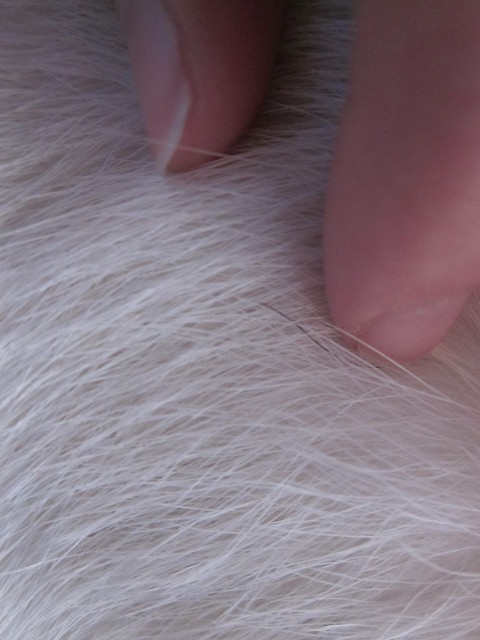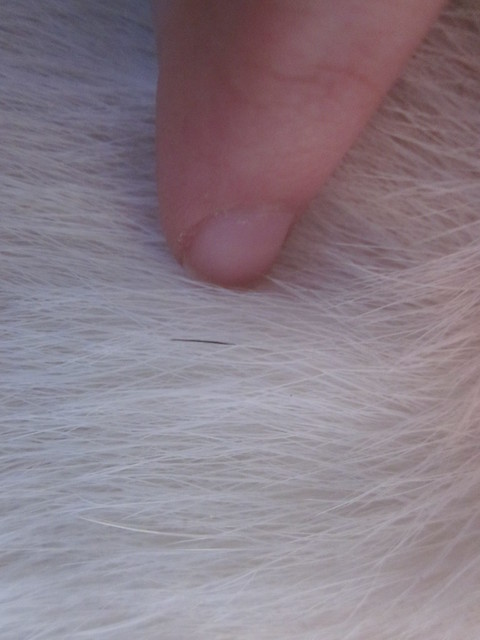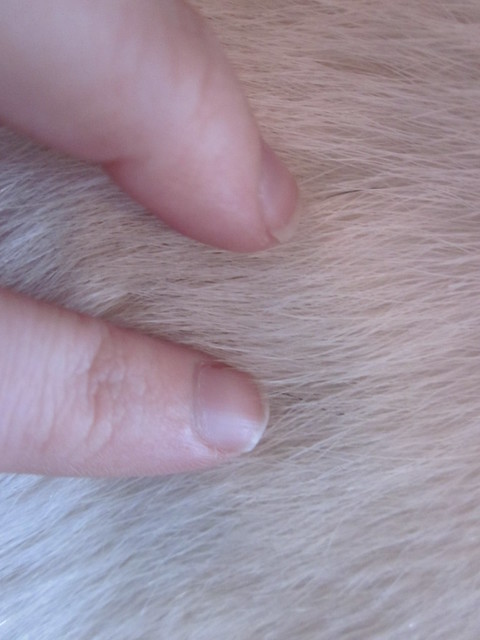Number of black 'hairs' on white dog increasing as he ages (UPDATE 2/28/2015)
I mentioned a while ago in Meitou's thread that I had found a black fur on one of Meitou's sides. He did not originally have this black fur as a puppy and super young dog and once I noticed this black fur it was the only one for a long time, but a month or so ago I found a different one in the middle of his back. And a week or two (or three?) ago I found two more on his shoulder right blade. The black fur is increasing increasing! Has anyone ever heard of this happening on other white dogs of other breeds? Or is Meitou just weird? (Well, that's a given, I suppose...)
I'm just curious about the genetics behind this because it find it amusing that over time he is getting more of them. Granted, it isn't very much more, but it is more. The most obvious one is the one on his back as it stands out the most. Also, these seem to be black only on the top half. Closer to the skin they are still white.
I am strange enough I tried to get pictures of them. Excuse the fingers, but I was trying to point the black strands out.
Excuse the fingers, but I was trying to point the black strands out.
Shoulder blade fur #1

Shoulder blade fur #2

On the back:

Shoulder blade

On the back. I'm holding on to most of the black to try and show that it turns white.

On his side.

I'm just curious about the genetics behind this because it find it amusing that over time he is getting more of them. Granted, it isn't very much more, but it is more. The most obvious one is the one on his back as it stands out the most. Also, these seem to be black only on the top half. Closer to the skin they are still white.
I am strange enough I tried to get pictures of them.
Shoulder blade fur #1

Shoulder blade fur #2

On the back:

Shoulder blade

On the back. I'm holding on to most of the black to try and show that it turns white.

On his side.


Comments
@Losech Yeah, it is very interesting. I'm curious, too. Since they look black to me it never occurred to me that they might be dark red, so now I want to know.
I wondered about it too.
But it's possible for a white dog to be pinto/extreme piebald. I think this is the case with Pyrenees and Dogo Argentino?
http://homepage.usask.ca/~schmutz/dogspots.html
The reason why I mentioned it is because Metou has obvious ruddy/cream/"yellow" color along his back and in the pictures - if he were an extreme piebald/pinto, you would expect him to have a more broken coat color (white vs. the ruddy ee cream).
Kurogane, Shirogane, and Fionna all have/had spotting I observed on top of their ee cream/white - they just had minimal spotting, not extreme piebald/pinto.
Fionna's white tail tip is very obvious now that her adult coat has grown in fairly dark. Shiro had a small blaze that split his "yellow" face as a young pup, but that seems to have faded, and Kurogane had a bit of a stripe on his stomach from the white spotting vs. ee red/cream/white (whatever one wants to call it).
I did take a few (really crappy) photos so maybe I'll try and upload those.
I always just assumed Meitou was red under his white. I know on his pedigree his paternal grandfather is red, and that dog's parents are both listed as red. All the other dogs that show up on his pedigree, including both parents, are white. Not sure if that means anything.
Edit:
This discussion got my wondering about coat color tests like what is offered by Animal Genetics: http://www.animalgenetics.us/Canine/Canine-color/Color_Index.asp
Because now I'm a little curious about it all, even if he does end up just being red. Would it be worth it?
The husky image Crispy posted above has a normal level of piebald patterning, with at least 25% or more in coloring. Titan, on the other hand, has less than 10% coloring with 2 siblings having only a spot on one eye and the other two having about 15% color.
Titan:
Titan's mom (with puppy Titan):
The reason I bring this up is because as Titan grew, he gained small black spots and hairs through out his body. Apparently that can happen with some, but not all, piebalds. This kind of came to mind with the discussion of black hairs on a white coat.
https://www.vgl.ucdavis.edu/services/dog.php
Though it's interesting, there are some piebald huskies where they have normal piebald patterning, or are mostly white, but the color doesn't recede back on their faces.